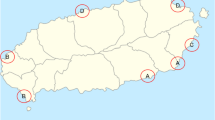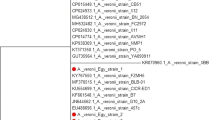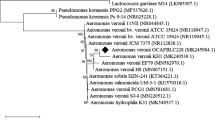Abstract
In 2005, massive mortality occurred in olive flounder Paralichthys olivaceus farms in Korea, and five isolates were collected from diseased fish. In this study, microbiological and pathogenic characteristics of these isolates were studied. The isolates gave negative results in lysine and ornithine decarboxylase, ortho-nitrophenyl-β-galactoside, and citrate tests, and positive results in urease, esculinase, and nitrate reduction tests. The isolates produced acid from adipate, fructose, d-glucose, and maltose, and gave positive results in alkaline phosphatase, esterase lipase, leucine arylamidase, and naphthol-AS-BI-phosphohydrolase. According to genetic analysis, 16S rRNA gene sequences showed 98–100 % identity with both Vibrio scophthalmi and V. ichthyoenteri. The dnaJ gene sequences presented a higher identity with V. scophthalmi than with V. ichthyoenteri. Thus, the isolates were identified as V. scophthalmi. Pathogenicity of the five isolates in olive flounder was different and LD50 values were from 106 to 108 CFU/g fish. Symptoms included darkening of skin, hemorrhage of liver and intestine, ascites, and distended abdomen. Histopathological changes included hemopoiesis dilatation and epithelial hyaline droplets in kidney, macrophage infiltration and ellipsoid dilatation in spleen, vascular dilatation, submucosal edema, and serosa inflammation of intestine. Cumulative mortality was 25 % for fish singly infected by isolate A19008 or Streptococcus parauberis, and increased to 87.5 % in super-infection group with these two pathogens.





Similar content being viewed by others
References
Yoon GH (2008) Aquaculture in Korea. Aquac News 34:1
Jung SJ, Kitamura S, Song JY, Joung IY, Oh MJ (2005) Complete small subunit rRNA gene sequence of the scuticociliate Miamiensis avidus pathogenic to olive flounder Paralichthys olivaceus. Dis Aquat Org 64:159–162
Kang BJ (2003) A study on the characteristics of bacteria isolated from cultured flounders Paralichthys olivaceus showing disease symptoms in Jeju Area of Korea (Ph.D. thesis). CheJu National University, Jeju City
Jo MR, Kim MC, Song CB (2006) Development of a rapid diagnosis kit for vibrios associated with the farmed olive flounder Paralichthys olivaceus in Jeju Island. J Fish Pathol F3
Won KM, Park SI (2008) Pathogenicity of Vibrio harveyi to cultured marine fishes in Korea. Aquaculture 285:8–13
Austin B, Alsina M, Austin DA, Blanch AR, Grimont F, Grimont PAD, Jofre J, Koblavi S, Larsen JL, Pedersen K, Tiainen T, Verdonck L, Swings J (1995) Identification and typing of Vibrio anguillarum: a comparison of different methods. Syst Appl Microbiol 18:285–302
Lee HG, Kim HJ, Kim I (1991) Isolation of Vibrio species from cultured flounders Paralichthys olivaceus with ulcers and ascites in the southern coast of Korea during the winter season. J Microbiol 29:319–328
Cerdà-Cuéllar M, Rosselló-Mora RA, Lalucat J, Jofre J, Blanch A (1997) Vibrio scophthalmi sp. nov., a new species from turbot Scophthalmus maximus. Int J Syst Bacteriol 47:58–61
Cerdà-Cuéllar M, Anicet RB (2004) Determination of Vibrio scophthalmi and its phenotypic diversity in turbot larvae. Environ Microbiol 6:209–217
Wang YG, Zhang Z, Qing L (2004) The main diseases of cultured turbot Scophthalmus maximus and their prevention and treatment. Mar Fish Res 25:61–68
Farto R, Montes M, Pérez MJ, Nieto TP, Larsen JL, Pedersen K (1999) Characterization by numerical taxonomy and ribotyping of Vibrio splendidus biovar I and Vibrio scophthalmi strains associated with turbot cultures. J Appl Microbiol 86:796–804
Roxana BH, Ilse C, Sabela B, Marjan DW, Fabiano LT, Jean S, Paul DV, Jesús LR (2008) Diversity of vibrios associated with reared clams in Galicia (NW Spain). Syst Appl Microbiol 31:215–222
Sugita H, Ito Y (2006) Identification of intestinal bacteria from Japanese flounder Paralichthys olivaceus and their ability to digest chitin. Lett Appl Microbiol 43:336–342
Eric G, Roxanna S, Kevin U, Jessica C, Marta GC (2006) Vibrio harveyi and other bacterial pathogens in cultured summer flounder Paralichthys dentatus. Aquaculture 260:10–20
Ariadna SB, Maria JP, Azucena B, Esperanza G, Pilar AP, Jaume PSN (2007) Bacteria associated with winter mortalities in laboratory–reared common dentex Dentex dentex L. Aquac Res 38:733–739
Thompson FL, Austin B, Swings J (2006) Biology of vibrios. American Society for Microbiology Press, Washington, DC
Sugita H, Okano R, Suzuki Y, Iwai D, Mizukami M, Akiyama N, Matsuura S (2002) Antibacterial abilities of intestinal bacteria from larval and juvenile Japanese flounder against fish pathogens. Fish Sci 68:1004–1011
Hoit JG, Krieg NR, Sneath PHA, Staley JT, Williams ST (1994) Bergey’s manual of determinative bacteriology, 9th edn. Lippincott Williams and Wilkins, Baltimore
Rashid MH, Kornberg A (2000) Inorganic polyphosphate is needed for swimming, swarming, and twitching motilities of Pseudomonas aeruginosa. Proc Natl Acad Sci USA 97:4885–4890
Darzins A (1993) The pilG gene product, required for Pseudomonas aeruginosa pilus production and twitching motility, is homologous to the enteric single-domain response regulator CheY. J Bacteriol 175:5934–5944
Colacite J, Nakamura CV, Ueda-Nakamura T, Filho BPD (2008) Virulence and antibiotic susceptibility of Aeromonas spp. isolated from drinking water. Antonie Van Leeuwenhoek 93:111–122
Zhang XH, Austin B (2000) Pathogenicity of Vibrio harveyi to salmonids. J Fish Dis 23:93–102
Liu PC, Lee KK, Chen SN (1996) Pathogenicity of different isolates of Vibrio harveyi in tiger prawn Penaeus monodon. Lett Appl Microbiol 22:413–416
Li H, Qiao G, Gu JQ, Zhou W, Li Q, Woo SH, Xu DH, Park SI (2010) Phenotypic and genetic characterization of bacteria isolated from diseased cultured sea cucumber Apostichopus japonicas in northeastern China. Dis Aquat Org 91:223–235
Weisburg WG, Barns SM, Pelletier DA, Lane DJ (1991) 16S ribosomal DNA amplification for phylogenetic study. J Bacteriol 173:697–703
Nhung PH, Shah MM, Ohkusu K, Noda M, Hata H, Sun XS, Iihara H, Goto K, Masaki T, Miyasaka J, Ezaki K (2007) The dnaJ gene as a novel phylogenetic marker for identification of Vibrio species. Syst Appl Microbiol 30:309–315
Wang FX, Zhou H, Ling H, Zhou HZ, Liu WH, Shao YM, Zhou J (2007) Subtype and sequence analysis of HIV-1 strains in Heilongjiang Province. Chin Med J 120:2006–2010
Tamura K, Dudley J, Nei M, Kumar S (2007) MEGA4: molecular evolutionary genetics analysis (MEGA) software version 4.0. Mol Biol Evol 24:1596–1599
Saitou N, Nei M (1987) The neighbor-joining methods: a new method for reconstructing phylogenetic trees. Mol Biol Evol 4:406–425
Posada D (2008) J model test: phylogenetic model averaging. Mol Biol Evol 25:1253–1256
Kimura M (1980) A simple method for estimating evolutionary rates of base substitutions through comparative studies of nucleotide sequences. J Mol Evol 16:111–120
Nieto TP, Toranzo AE, Barja JL (1984) Comparison between the bacterial flora associated with fingerling rainbow trout cultured in two different hatcheries in the north-west of Spain. Aquaculture 42:193–206
Muhammad AR (2009) Calculation of LD50 values from the method of Miller and Tainer, 1944. J Ayub Med College Abbottabad 21:184–185
Cho MY, Lee JI, Kim MS, Choi HJ, Lee DC, Kim JW (2008) Isolation of Streptococcus parauberis from starry flounder Platichthys stellatus Pallas. J Fish Pathol 21:209–217
Kiernan JA (2008) Histological and histochemical methods: theory and practice, 4th edn. Scion, Bloxham
Mittal KR, Lalonde G, Leblanc D, Olivier G, Lallier R (1980) Aeromonas hydrophila in rainbow trout: relation between virulence and surface characteristics. Can J Microbiol 26:1501–1503
Santos Y, Toranzo AE, Barja JL, Nieto TP, Villa TG (1988) Virulence properties and enterotoxin production of Aeromonas strains isolated from fish. Infect Immun 56:3285–3293
Kim DH, Han HJ, Kim SM, Lee DC, Park SI (2004) Bacterial enteritis and the development of the larval digestive tract in olive flounder Paralichthys olivaceus (Temminck & Schlegel). J Fish Dis 27:497–505
Buller NB (2003) Bacteria from fish and other aquatic animals: a practical identification manual. CABI, Wallingford, p 135
Montes M, Farto R, Pérez MJ, Armadaa SP, Nieto TP (2006) Genotypic diversity of Vibrio isolates associated with turbot Scophthalmus maximus culture. Res Microbiol 157:487–495
Hanage WP, Kaijalainen T, Herva E, Saukkoriipi A, Syrjänen R, Spratt BG (2005) Using multilocus sequence data to define the Pneumococcus. J Bacteriol 187:6223–6230
Thompson FL, Gevers D, Thompson CC, Dawyndt P, Naser S, Hoste B, Munn CB, Swings J (2005) Phylogeny and molecular identification of vibrios on the basis of multilocus sequence analysis. Appl Environ Microbiol 71:5107–5115
Yamada-Noda M, Ohkusua K, Hatac H, Shaha MM, Nhunga PH, Song XS, Hayashia M, Ezakia M (2007) Mycobacterium species identification—a new approach via dnaJ gene sequencing. Syst Appl Microbiol 30:453–462
Liu H, Li Y, Huang X, Kawamura Y, Ezaki T (2003) Use of the dnaJ gene for the detection and identification of all Legionella pneumophila serogroups and description of the primers used to detect 16S rDNA gene sequences of major members of the genus Legionella. Microbiol Immunol 47:859–869
Itoh Y, Kawamura Y, Kasai H, Shah MM, Nhung PH, Yamada M, Sun XS, Koyana T, Hayashi M, Ohkusu K, Ezak T (2006) DnaJ and gyrB gene sequence relationship among species and strains of genus Streptococcus. Syst Appl Microbiol 29:368–374
Shah MM, Iihara H, Noda M, Sun XS, Nhung PH, Ohkusu K, Kawamura Y, Ezaki T (2007) DnaJ gene sequence based assay for species identification and phylogenetic grouping in the genus Staphylococcus. Int J Syst Evol Microbiol 57:25–30
Nhung PH, Hata H, Ohkusu K, Noda M, Shah MM, Goto K, Ezaki T (2007) Novel phylogenetic marker dnaJ and DNA–DNA hybridization for clarifying interrelationships among the genus Aeromonas. Int J Syst Evol Microbiol 57:1232–1237
Nhung PH, Ohkusu K, Mishima N, Noda M, Shah MM, Sun XS, Hayashi M, Ezaki T (2007) Phylogeny and species identification of the family Enterobacteriaceae based on dnaJ sequences. Diagn Microbiol Infect Dis 58:153–161
Fouz B, Juan LB, Carmen A, Carmen R, Alicia ET (1993) Toxicity of the extracellular products of Vibrio damsela isolated from diseased fish. Curr Microbiol 27:341–347
Lee DC, Kim YC, Kim JW, Park SI (2005) Effect of Edwardsiella tarda ECPs on immune function in olive flounder Paralichthys olivaceus. J Fish Pathol 18:215–225
Nishimori E, Hasegawa O, Numata T, Wakabayashi H (1998) Vibrio carchariae causes mass mortalities in Japanese abalone Sulculus diversicolor supratexta. Fish Pathol 33:495–502
Soffientino B, Gwaltney T, Nelson DR, Specker JL, Mauel M, Gómez–Chiarri M (1999) Infectious necrotizing enteritis and mortality caused by Vibrio carchariae in summer flounder Paralichthys dentatus during intensive culture. Dis Aquat Org 38:201–210
Lee KK, Liu PC, Chuang WH (2002) Pathogenesis of gastroenteritis caused by Vibrio carchariae in cultured marine fish. Mar Biotechnol 4:267–277
Blanch AR, Alsina M, Simoń M, Jofre J (1997) Determination of bacteria associated with reared turbot Scophthalmus maximus larvae. J Appl Microbiol 82:729–734
Cerdà–Cuéllar M, Blanch AR (2002) Detection and identification of Vibrio scophthalmi in the intestinal microbiota of fish and evaluation of host specificity. J Appl Microbiol 93:261–268
Muroga K, Yasunobu H, Okada N, Masumura K (1990) Bacterial enteritis of cultured flounder Paralichthys olivuceus larvae. Dis Aquat Org 9:121–125
Ishimaru KM, Akagawa–Matsushita Muroga K (1996) Vibrio ichthyoenteri sp. nov., a pathogen of Japanese flounder Paralichthys olivaceus larvae. Int J Syst Bacteriol 46:155–159
Montes M, Farto R, Pérez MJ, Nieto TP, Larsen JL, Christensen H (2003) Characteristics of Vibrio strains isolated from turbot Scophthalmus maximus culture by phenotypic analysis, ribotyping and 16S rRNA gene sequence comparison. J Appl Microbiol 95:693–703
Zorrilla I, Arijo S, Chabrillon M, Díaz-Rosales P, Martínez-Manzanares E, Balebona MC, Moríňigo MA (2003) Vibrio species isolated from diseased farmed sole Solea senegalensis (Kaup) and evaluation of the potential virulence role of their extracellular products. J Fish Dis 16:103–108
Devesa S, Barja JL, Toranzo AE (1989) Ulcerative skin and fin lesions in reared turbot Scophthalmus maximus. J Fish Dis 12:323–333
Nowak MA, May RM (1994) Superinfection and the evolution of parasite virulence. Proc R Soc B 255:81–89
Saldaña J, Elena SF, Solé RV (2003) Coinfection and superinfection in RNA virus populations: a selection–mutation model. Math Biosci 183:135–160
Author information
Authors and Affiliations
Corresponding author
Rights and permissions
About this article
Cite this article
Qiao, G., Lee, D.C., Woo, S.H. et al. Microbiological characteristics of Vibrio scophthalmi isolates from diseased olive flounder Paralichthys olivaceus . Fish Sci 78, 853–863 (2012). https://doi.org/10.1007/s12562-012-0502-8
Received:
Accepted:
Published:
Issue Date:
DOI: https://doi.org/10.1007/s12562-012-0502-8




